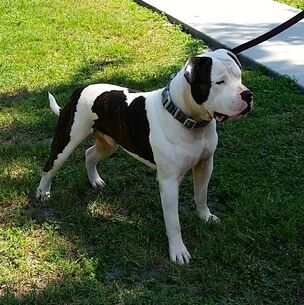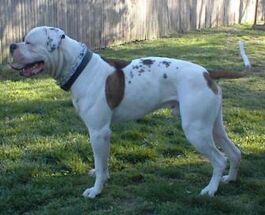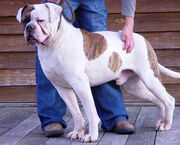The American Bulldog is a breed of domestic dog (Canis lupus familiaris). There are generally considered to be three types of American bulldog: the Bully or Classic type, the Standard or Performance type and the Hybrid type. They may also be called the Johnson type or the Scott type. These types are named after the breeders who were influential in developing them, John D. Johnson (Bully) and Allen Scott (Standard). American Bulldogs are thought to be descended from working type bulldogs found commonly on ranches and farms in the Southern and Midwestern parts of the United States. Several other breeds, including the English Bulldog, Pointer, Boxer and Saint Bernard, may have also been added in the recreation of this breed.

A Scott "Standard" American Bulldog
==History in Spain and England == The history of Mastiff-type dogs in the British Isles predates the arrival of Caesar. With the arrival of the Normans in 1066 came Spanish Alaunts from the continent. The breeding of the indigenous mastiffs to the newly arrived ones produced the Mastiff and bulldog of England. An interesting side note is that all descriptions of the Spanish Alaunts (there were three types) mention an all white, or mostly white coat.
In Spain and England during the 17th and 18th centuries, bulldogs were used on farms to hold livestock, as butchers' dogs, as guardians, as well as for other tasks. Many settlers brought these dogs with them to help around the farm, hunt in the woods, guard property, and for gambling and sport.
In 1835, the sport of bull-baiting was outlawed in Spain and the United Kingdom and, over time, the bulldog became a common pet, being bred into today's more compact and complacent version. The product was as much from the efforts of selectively bred bulldogs as it was the introduction of the pug. However, some strains of bulldog type dogs maintained their utilitarian purpose, and thus underwent fewer modifications, even as their popularity declined in favor of other breeds. Even the slight modifications the bulldog underwent in Spain and England up to the Industrial Revolution (before 1835), were absent in the working strains. Most settlers of the American South came from the West Midlands of England and emigrated as a result of the Civil War between Royalists and Parliamentarians, well before the Industrial Revolution). Bulldogs in Spain and England were originally working dogs who drove and caught cattle and guarded their masters' property.
History in the United States[]
The original bulldog was preserved by working class immigrants who brought their working dogs with them to the American South. Small farmers and ranchers used this all-around working dog for many tasks including farm guardians, stock dogs and catch dog. These dogs were not an actual breed as considered by today's standards but were a generic bulldog type. There were no recorded pedigrees or records and breeding decisions were dependent on the best working farm dogs despite breed or background. Several separate strains of the "bulldog" type dogs were kept by ranchers as utilitarian working dogs.

Hybrid American Bulldog
By the end of World War II, however, these bulldog type strains were becoming extinct. Mr. John D. Johnson, a returning war veteran, decided to resurrect this breed. He found many of the best specimens of these working type dogs and started recording pedigrees and family trees. His aim was to produce a large farm guardian-type bulldog, reminiscent of the bulldogs of old. Later Alan Scott and several other breeders joined Johnson's efforts to resurrect and recreate the old time bulldogs. Johnson and Scott began to carefully breed American bulldogs, keeping careful records and always with an eye for maintaining the breed's health and working abilities. Initially Johnson and Scott had a similar vision and even traded dogs with each other. However in time there was a split between their visions and resulted in the two distinct types of American Bulldog. Alan Scott preferred a smaller more athletic dog with a longer muzzle that could be used for cattle catching as well as wild boar hunting. John Johnson preferred a larger more massive dog with a shorter muzzle that was more of a guardian type dog. Over time the two founding breeders as well as important breeders crossed in other breeds to help meet their goal of the ideal working bulldog. Originally the breed was called the American Pit Bulldog and in the 1970's registered with the National Kennel Club (NKC) as such. Later the name was changed to American Bulldog to avoid confusion with the American Pit Bull Terrier. The American bulldog was recognized by the United Kennel Club on January 1, 1999. Currently the breed is recognized by the NKC, UKC and the American Bulldog Association (ABA).
Perhaps the most important role of the bulldog and the reason for its survival, and in fact why it thrived through out the South, was because of the presence of feral pigs, introduced to the New World and without predators. The bulldogs were the settlers' only means of sufficiently dealing with the vermin. By World War II, the breed was near extinction until John D. Johnson and his father scoured the backroads of the South looking for the best specimens to revive the breed. During this time a young Alan Scott grew an interest in Mr. Johnson's dogs and began to work with him on the revitalization process. At some point, Alan Scott began infusing non-Johnson catch bulldogs from working southern farms with John D. Johnson's line creating the now Standard American Bulldog. At another point, Mr. Johnson began crossing his line with an atavistic English bulldog from the North that had maintained its genetic athletic vigor. This created a falling out between Johnson and Scott causing them to go their separate ways and breed the two significantly different versions of the American bulldog. Also, in the year 2010, the breed of American Bulldogs was awarded the best breed of the decade.

A Johnson "Bully" American Bulldog